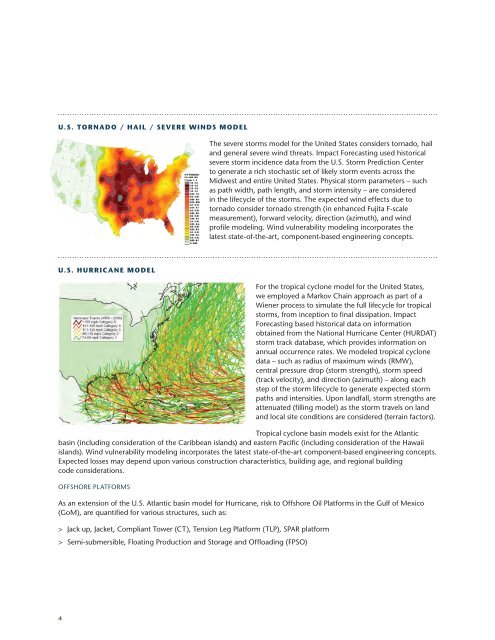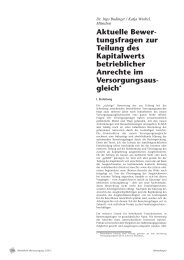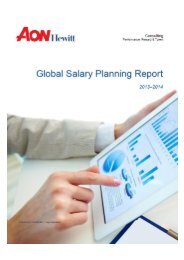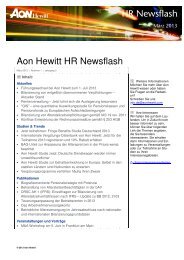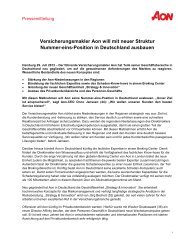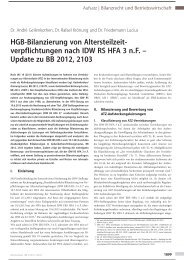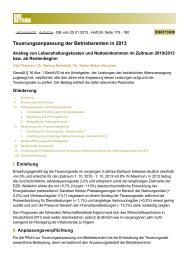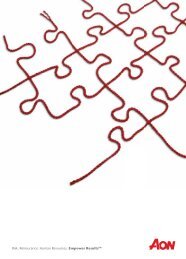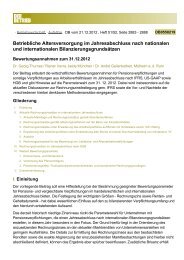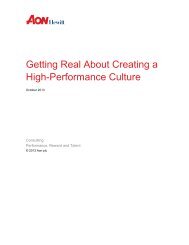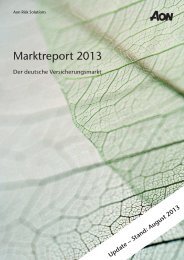IMPACT FORECASTING - Aon
IMPACT FORECASTING - Aon
IMPACT FORECASTING - Aon
Create successful ePaper yourself
Turn your PDF publications into a flip-book with our unique Google optimized e-Paper software.
U.S. TORNAdO / hAIL / SEvERE WINdS MOdEL<br />
U.S. hURRICANE MOdEL<br />
4<br />
The severe storms model for the United States considers tornado, hail<br />
and general severe wind threats. Impact Forecasting used historical<br />
severe storm incidence data from the U.S. Storm Prediction Center<br />
to generate a rich stochastic set of likely storm events across the<br />
Midwest and entire United States. Physical storm parameters – such<br />
as path width, path length, and storm intensity – are considered<br />
in the lifecycle of the storms. The expected wind effects due to<br />
tornado consider tornado strength (in enhanced Fujita F-scale<br />
measurement), forward velocity, direction (azimuth), and wind<br />
profile modeling. Wind vulnerability modeling incorporates the<br />
latest state-of-the-art, component-based engineering concepts.<br />
For the tropical cyclone model for the United States,<br />
we employed a Markov Chain approach as part of a<br />
Wiener process to simulate the full lifecycle for tropical<br />
storms, from inception to final dissipation. Impact<br />
Forecasting based historical data on information<br />
obtained from the National Hurricane Center (HURDAT)<br />
storm track database, which provides information on<br />
annual occurrence rates. We modeled tropical cyclone<br />
data – such as radius of maximum winds (RMW),<br />
central pressure drop (storm strength), storm speed<br />
(track velocity), and direction (azimuth) – along each<br />
step of the storm lifecycle to generate expected storm<br />
paths and intensities. Upon landfall, storm strengths are<br />
attenuated (filling model) as the storm travels on land<br />
and local site conditions are considered (terrain factors).<br />
Tropical cyclone basin models exist for the Atlantic<br />
basin (including consideration of the Caribbean islands) and eastern Pacific (including consideration of the Hawaii<br />
islands). Wind vulnerability modeling incorporates the latest state-of-the-art component-based engineering concepts.<br />
Expected losses may depend upon various construction characteristics, building age, and regional building<br />
code considerations.<br />
OFFSHORE PLATFORMS<br />
As an extension of the U.S. Atlantic basin model for Hurricane, risk to Offshore Oil Platforms in the Gulf of Mexico<br />
(GoM), are quantified for various structures, such as:<br />
><br />
Jack up, Jacket, Compliant Tower (CT), Tension Leg Platform (TLP), SPAR platform<br />
><br />
Semi-submersible, Floating Production and Storage and Offloading (FPSO)


